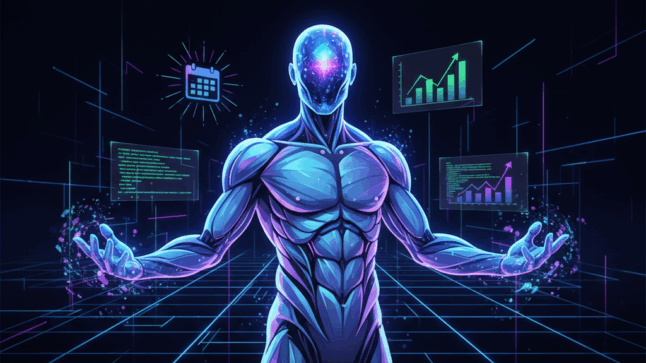Digital strategy, my focus for the past ten years, has been evolving into AI strategy. And really into Agentic AI strategy.
Really, we are talking about the business implications of new tools, technologies and business models being created by:
- GenAI
- AI Agents
- Embodied intelligence and robots
In terms of concepts, it’s mostly about:
- Rapid learning and adaptation, and intelligence as capabilities.
McKinsey & Co describes all this as a paradigm shift, from the digital era to the AI era. This is summarized in their below graphic. It is worth reading through this graphic in detail.

I don’t totally agree with that. But not a bad point. I view this as:
- Digital business, which is well understood with tons of real-world results to study. Over 25 years. This includes analytical and predictive AI.
- Gen AI / Agentic business, which is just emerging. It’s lots of pilots. Lots of theory. And somethings being deployed at scale. But it’s early days.
I think we are looking at two complementary systems. With different tech architecture, data systems and interactions with users. Not a transition from one era to another. I think this is quite well described with 4 levels shown below.
–
And we do need a GenAI / Agentic Strategy. We have a Digital Strategy, see below.
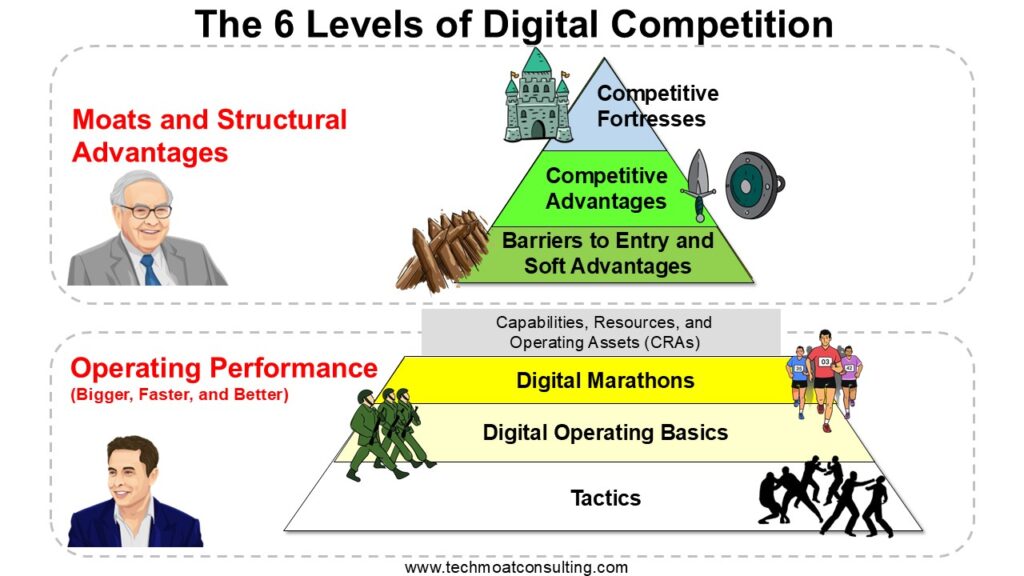
We can look at GenAI / Agentic strategy with the same approach:
- Business model and structural advantages:
- What are the barriers to entry and competitive advantages?
- How about operating marathons?
- Is learning and adaptation a competitive advantage?
- Is intelligence a barrier to entry?
- What competitive advantages and barriers are being wiped out? Definitely, standardization network effects.
- Operating model and performance:
- How do we use these tools and business models for faster, smarter and better operations?
This article is a framework for operating models. I’ll summarize business model and structural advantages shortly.
For GenAI / Agentic operating models, it helps to break this into internal vs external. Internal operations are easier to understand and more controllable. External is about how you interact with customers, industries and ecosystems, which are also being changed by GenAI and agents. It’s way more complicated. I’ll start with internal.
Focus on GenAI / Agent Workflows. And Map Each Workflow to 4 Levels.
Internal operations are all about workflows. Don’t think about agents or tools. Think about workflows. That’s the key to translating everything to value for customers and users.
Workflows are people, processes and technologies. That together accomplish standardized outcomes. And GenAI and AI Agents are changing all three components.
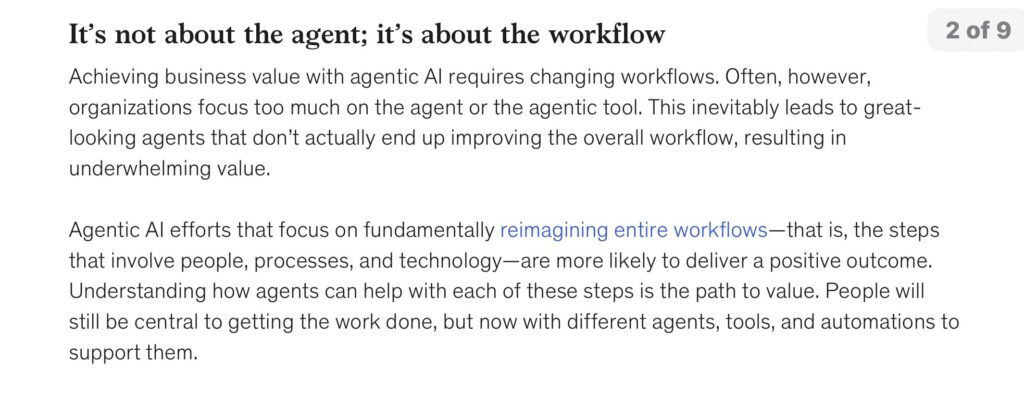
Here are the 4 levels I mentioned earlier.
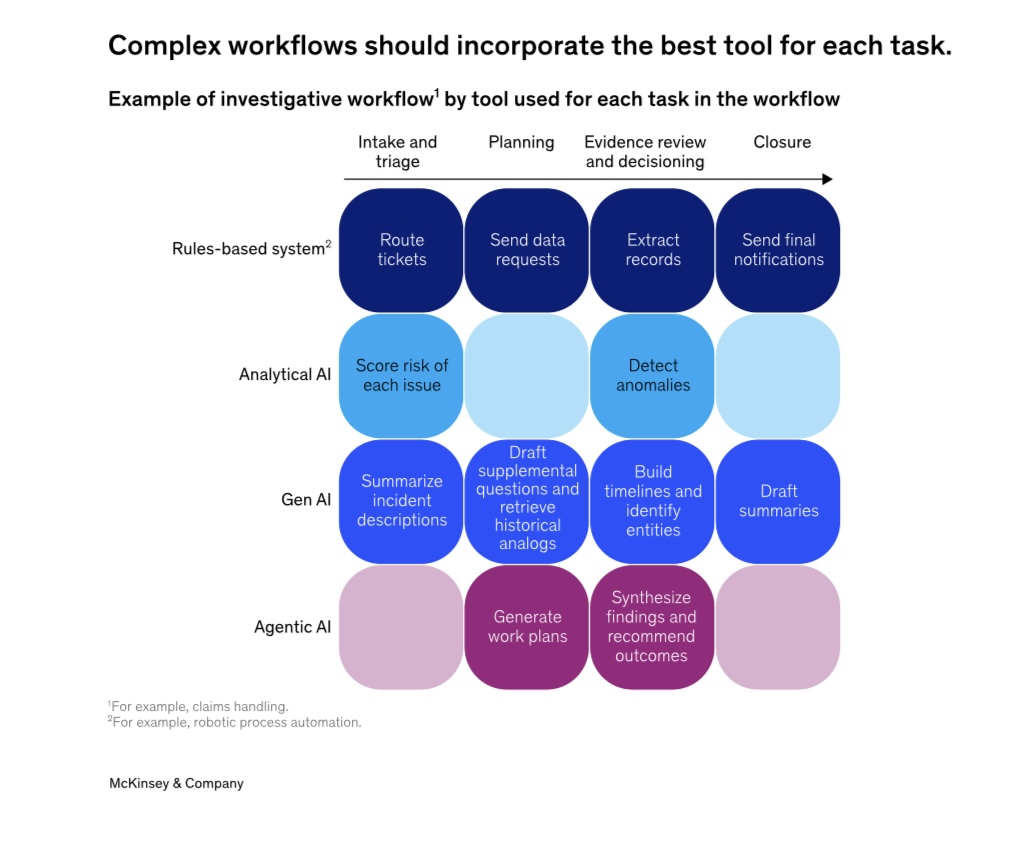
This is a really helpful framework. You can map a workflow from left to right (in its steps or tasks). Then look at it with these four levels:
- Rules-based system. This is traditional software.
- Analytical AI. I also put predictive AI here.
- Generative AI
- Agentic AI
I consider 1 and 2 as digital business. And 3 and 4 as GenAI / Agentic business.
As mentioned, these all have pretty different tech stacks. And definitely the data requirements are different. And they produce fundamentally different types of outcomes within the workflow. For example:
- Low variance and high standardization tasks do well with rules-based software systems. Such as financial reporting and regulatory disclosures. You want highly deterministic and accurate outcomes. It’s rules based.
- And these low variance and high standardization steps don’t do well with generative AI and non-deterministic foundational models. You don’t want different results for the same prompt. This can add complexity and uncertainty.
- Levels 3 and 4 do better with low standardization and high variance steps. Such as whether to approve a loan or not. And creating marketing materials.
McKinsey has good articles on agents (and on the four levels).
- The agentic organization: Contours of the next paradigm for the AI era
- The change agent: Goals, decisions, and implications for CEOs in the agentic age
And a main point is you need to treat AI Agents like people. They are non-deterministic and are closer to people than traditional software. Consistent quality is really a problem. AI slop is a big problem. And you need to address the quality issue within a workflow before you can scale it up.
That means you need to do lots of training and investment, just like with people.
You do lots of training and oversight. You need to track and verify agents at each step of a workflow (like employees). You need to verify performance, catch mistakes, refine the logic, and get feedback to improve performance. In each workflow. Only then can you scale up.
And ideally, you want to reuse the same agents for lots of use cases, just like with data products and with employees. You don’t want lots and lots of highly specific agents.
GenAI / Agentic Organizations Have 4 Stages
4 levels and 4 stages. I like this as a framework. It’s McKinsey thinking by my term. 🙂
GenAI / Agentic organizations should evolve over time in 4 stages. The below graphic is worth going through in detail.
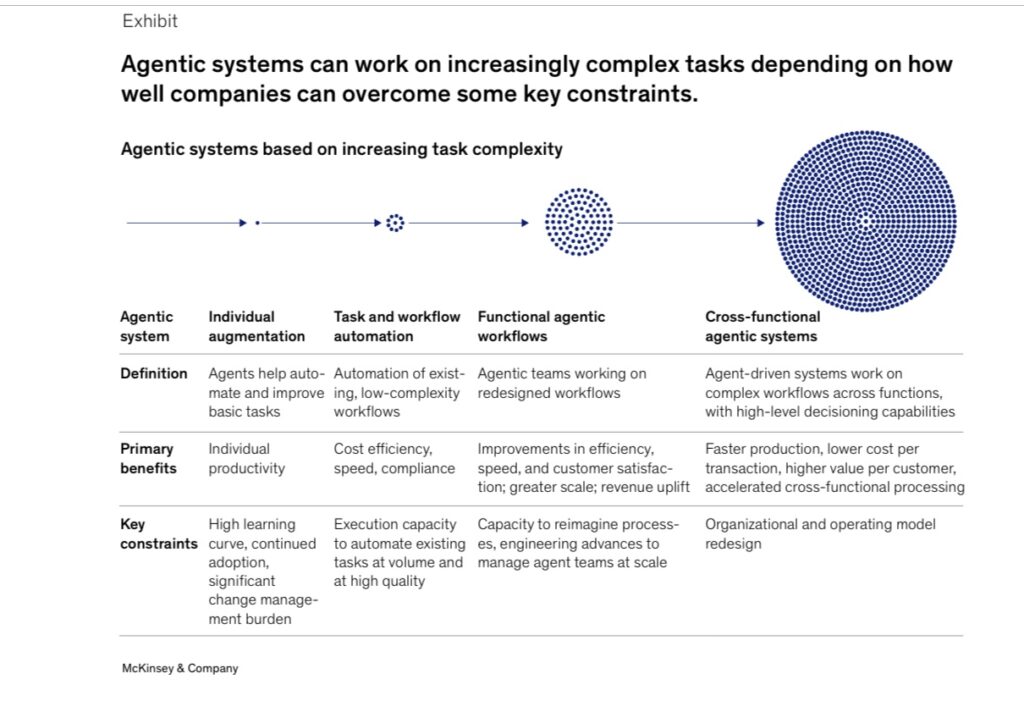
Stage 1: Individual Augmentation and Automation
This is where most businesses are today. Individuals are becoming way more productive using GenAI tools. Which increasingly includes agents. Basic tasks are being improved and automated. Think drafting contracts and summarizing meeting notes.
Agents are a big upgrade to GenAI. They can gather data, make decisions and execute on their own. And the size of the tool kit they can draw on is getting bigger really fast.
Here is a summary of agent architecture (from Google’s September 2024 whitepaper on AI Agents by Julia Wiesinger, Patrick Marlow, and Vladimir Vuskovic).
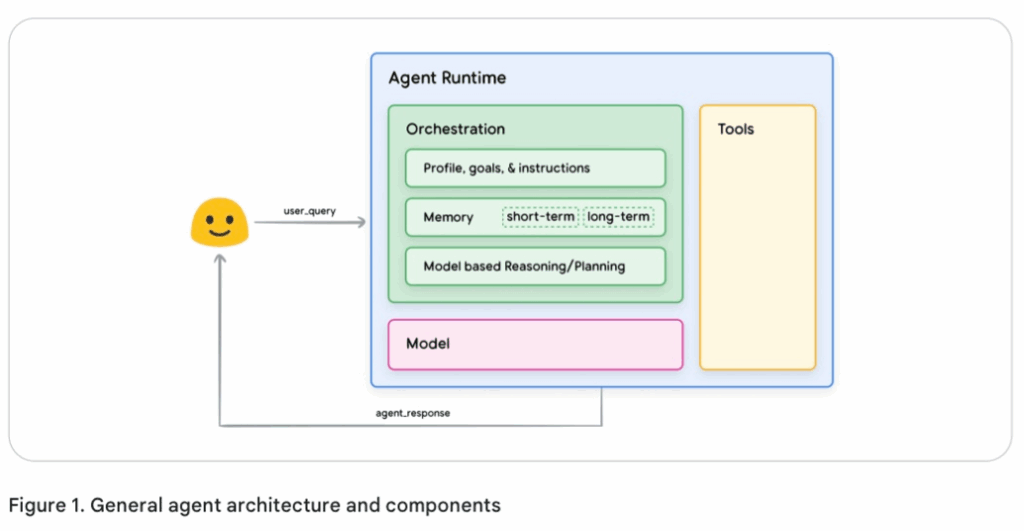
The orchestration layer is key.
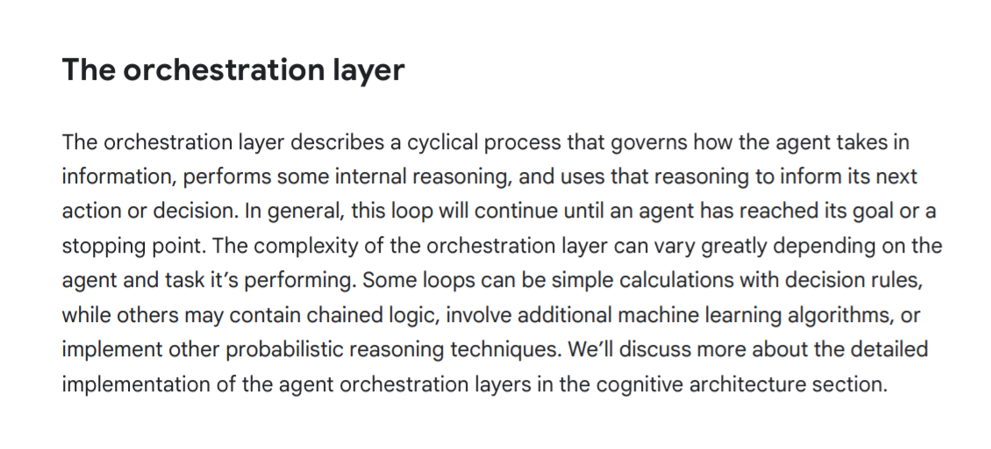
Here is an example for an internal agent for human resources.
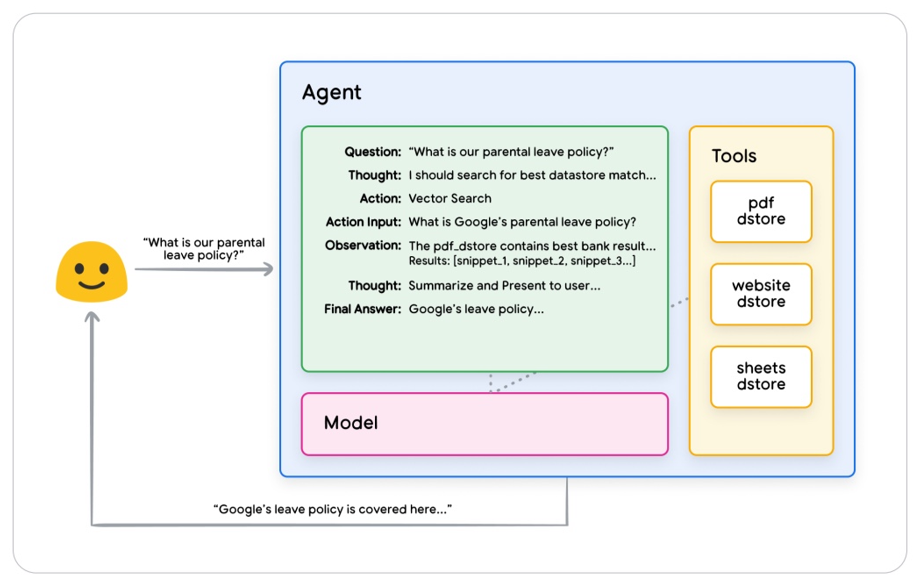
Stage 2: Automate Tasks and Workflows
Here the business moves from automating tasks to entire workflows. But these are basic workflows, with low complexity. You should get a big jump in cost efficiency, speed and quality (usually).
Stage 3: Functional AI Agentic Workflows
This is where things take a big step forward.
First, this is where you have teams of agents. That’s a big deal. Think about one agent creating an output and a second agent using that as an input. Think about how much digital tools can scale. Think hundreds of agents.
And it’s about redesigning workflows to the AI-first. That’s another big step forward. This is where we abandon operations that were designed around humans.
The holy grail is teams of agents working on workflows that have been redesigned to be AI-first. And now we are talking about a human-AI hybrid operating model. An nobody really knows what that means yet. What is a non-human workforce? What is a non-human powered business?
The simpler version of this is when the AI-first workflows are more functional. Such as for running call centers, doing financial reporting., and managing inventory. There are lots of vendors already selling these types of solutions.
Stage 4: Cross Functional AI Agentic Systems
Look at the graphic again. You’ll notice this stage is much larger.
This is the more advanced version of a human-AI hybrid operation model. It’s still mostly about agent teams doing AI-first redesigned workflows. But the workflows are now cross-functional. They reach across the organization. Such as:
- Managing the end-to-end customer experience
- Overseeing field operations
- Managing inventory and the supply chain.
And these can include high-level decisioning capabilities.
In this stage, I would also put internal coordination. Much of organizational structure and activities is humans meeting and discussing. Sharing knowledge. Writing reports. Doing meetings. Agents can handle much of this “coordination tax”. Sanjeet Choudary talked about this in his book Reshuffle, which I wrote about here.
How to Start Building Agentic AI Operations Today: 4 Pillars.
4 Levels and 4 Stages is a good way to think about GenAI / Agentic workflows.
But what is an “agentic organization”?
McKinsey & Co says such organizations have business models with 5 pillars. I’m not going to go through that because I don’t really agree with a lot of it. But the link is above.
For business model, they mention an agentic organization should:
- Getting close to customers with hyper personalization with AI native channels.
- AI first workflows that drop costs and improve performance
- Proprietary data that creates differentiation.
Not bad. It’s always important to tie digital and AI initiatives as close to customer value as possible.
But I think an agentic organization has 4 pillars:
- Operating model. As discussed. With AI-first workflows. And with agent teams as the primary building blocks. Plus, cross-organization orchestration of agent teams.
- Hybrid workforce, with new talent profiles.
- Technology and data
- Governance
Here’s some excerpts from the McKinsey paper. Worth reading.
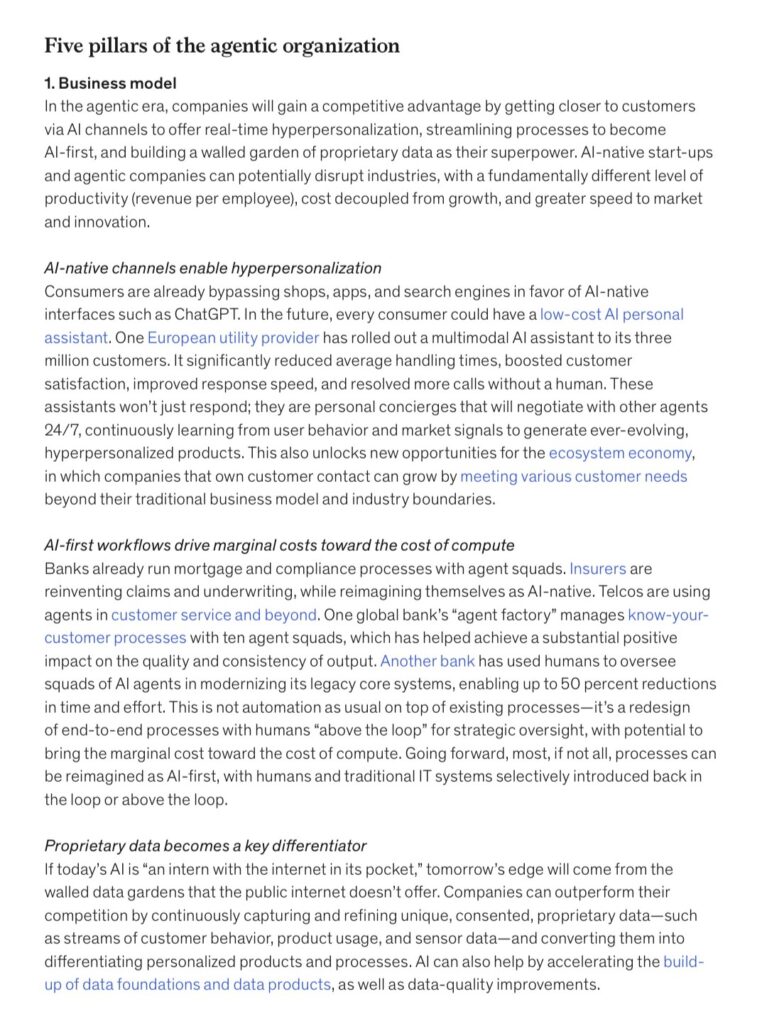
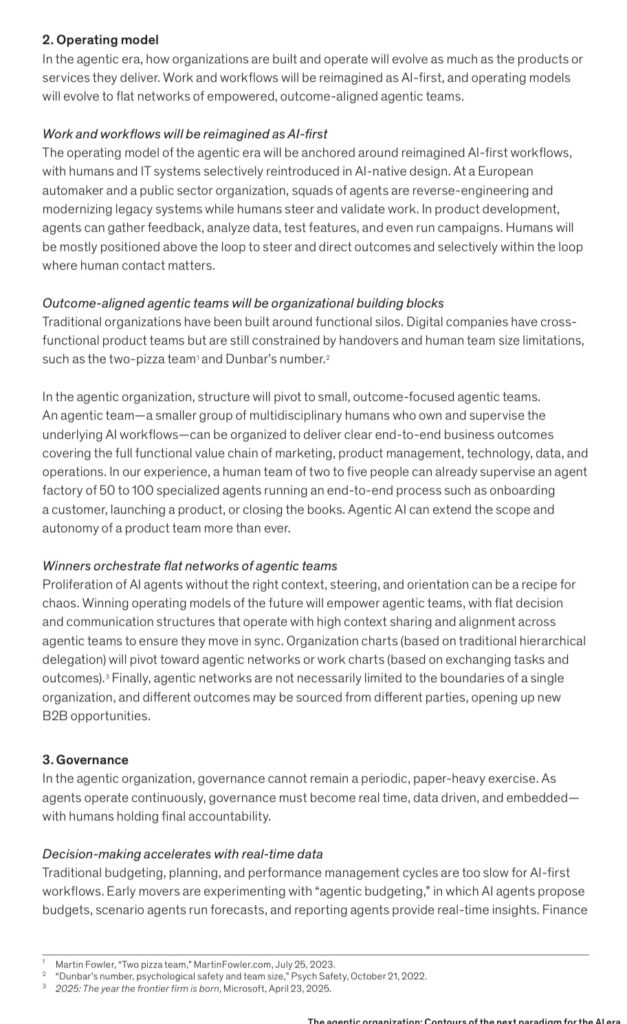
I like the focus on agent teams as the building blocks of organizations. It emphasizes the need to make these teams plug and play. And not too specific.
Talent and workforce is an important pillar. A human-AI hybrid workforce requires new talent profiles.
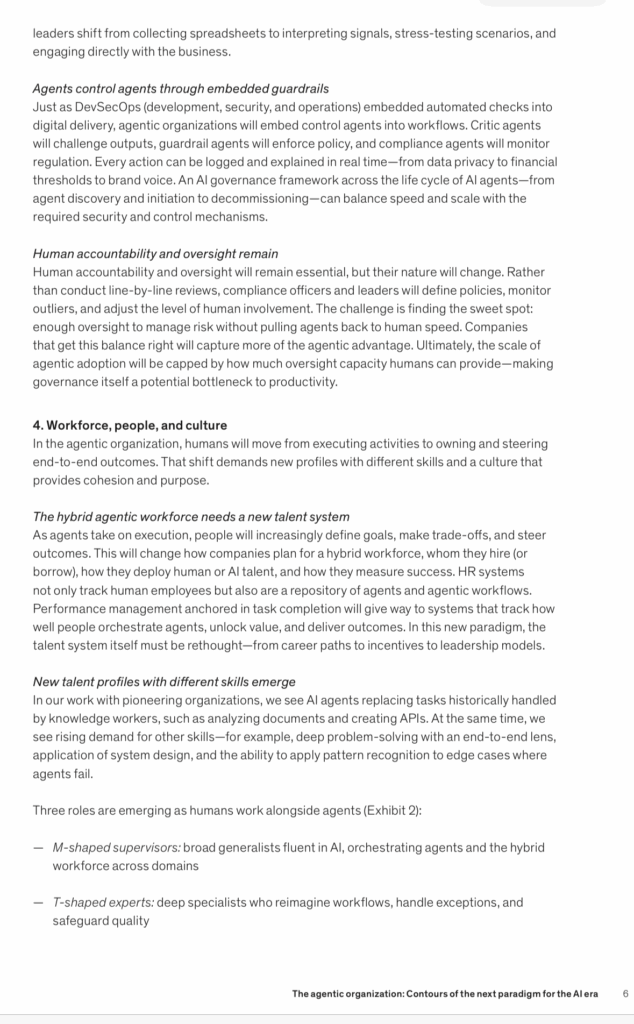
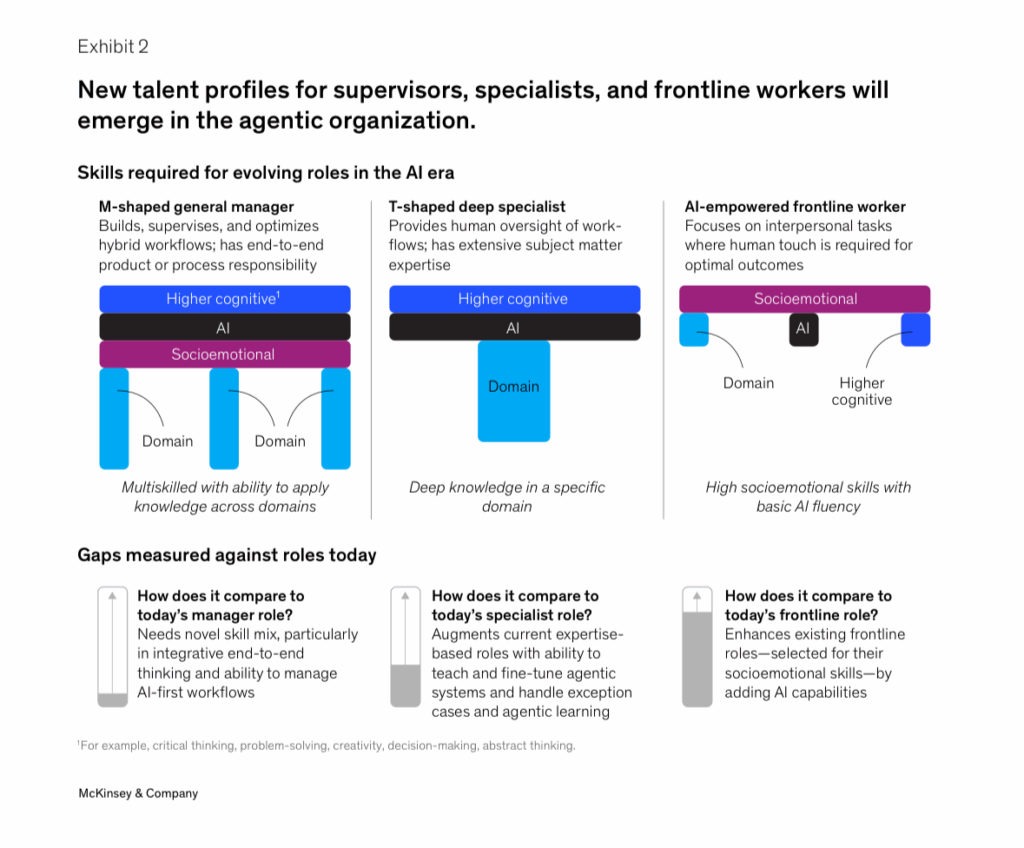
And finally, there is Technology and Data.
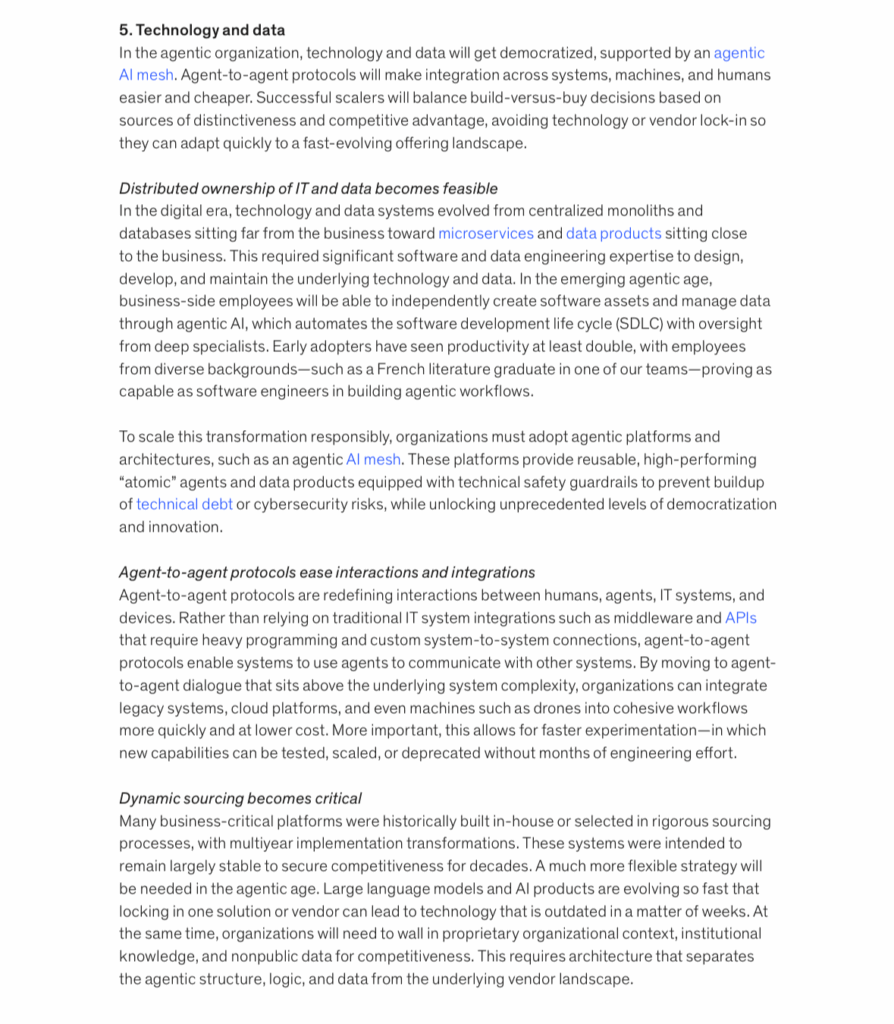
***
Ok. That’s most of what I wanted to cover.
Just for contrast, here is an approach by Boston Consulting Group. Similar but a bit too simple I think.
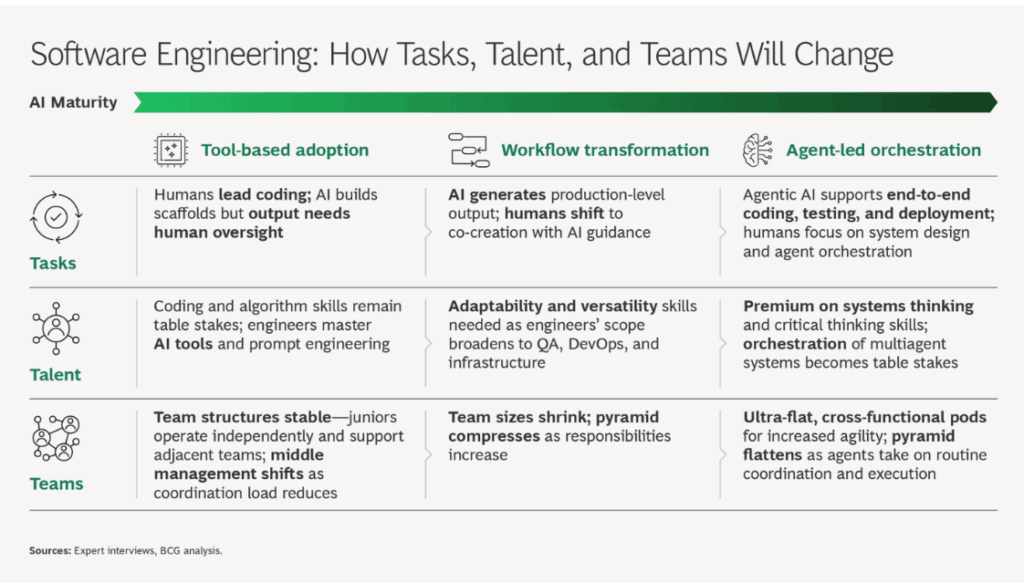
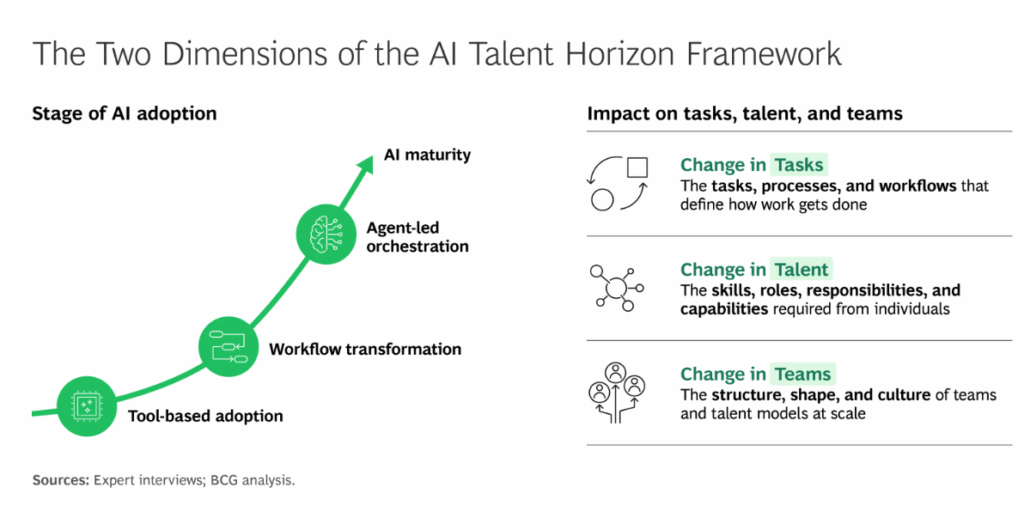
What to Watch for in GenAI / Agent Operating Models
Here is a good list of next steps for watch for. This is mostly theory at this point. But interesting.
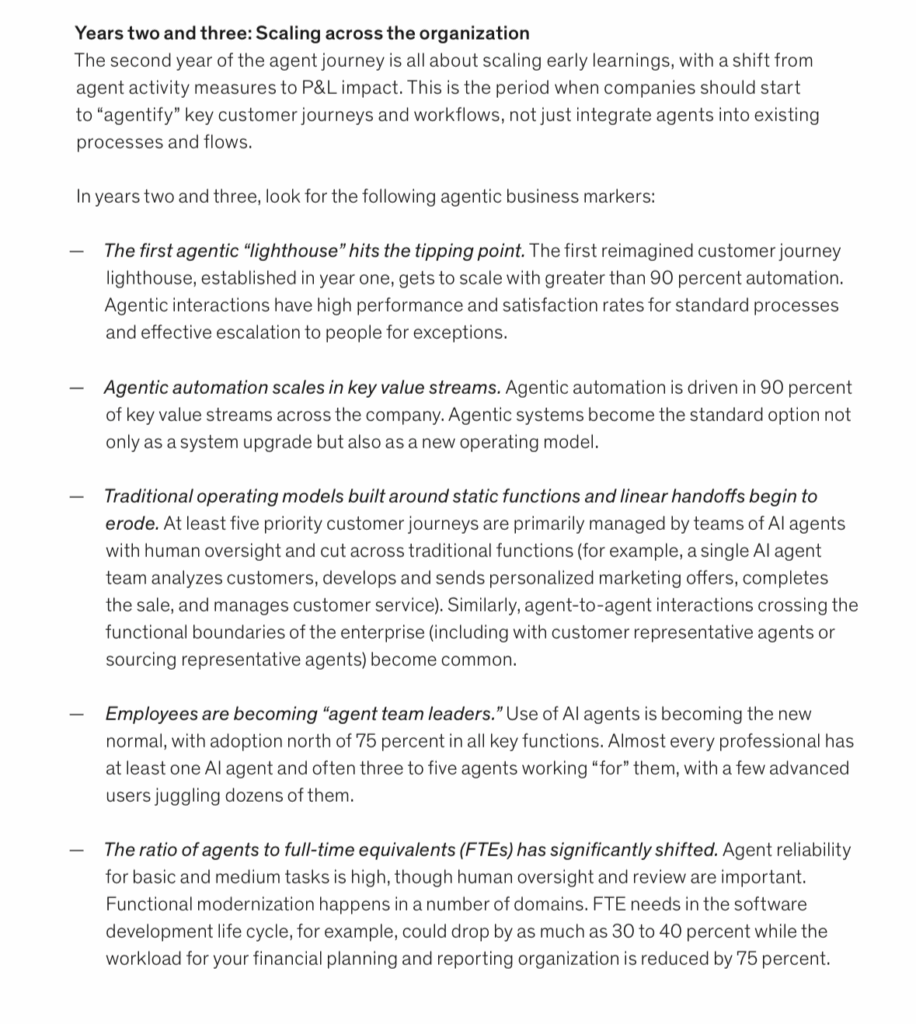
Last Point: Ecosystems Are Being Completely Transformed by Agentic AI
I am publishing an article about FDI Retail in Hong Kong. The CDO of that big retailer said their strategy was to be omnipresent in the omnichannel.
I thought that was a good description of what most businesses have been doing in the digital age. They are going where the customers are (online retail, social media, search engines, physical stores) and then trying to be super present (SEO, content creation, etc.).
However, the entire external ecosystem that businesses engage with may be changing.
The operating model for Agentic AI I laid out focused on internal operations. But the most important workflows are those that interact with the external environment, especially customers, suppliers and complementors.
In the external ecosystem, it’s all about human-to-human interactions (even when it is a business). For example, websites, SEO, search, etc. are all about human created content and then human consumption.
And GenAI and AI agents are already turning this upside down.
- About half of online content is now AI created. And this is increasing rapidly. Volume is increasing. And a lot of it is AI slop.
- Consumption of content is increasingly by AI and AI agents. Not humans.
- The algorithm that connects content creation and consumption is getting distorted by all this AI activity on both sides.
- New mechanisms for consumption (ChatGPT) are killing search engines. SEO is becoming less useful. Websites are becoming hidden.
So, it’s not clear what happening here. Everything is getting turned upside down. And my main point is that your operating model for the external environment is going to have to change. But it’s hard to know what to do right now.
Ok. that’s it for today.
Jeff
——
Related articles:
- How to Build an Agentic AI Operating Model (Tech Strategy – Podcast 263)
- Tencent Cloud and Mini Programs Go International. Lessons from My Visit to Tencent HQ. (2 of 2) (Tech Strategy)
- How Amap Beat Baidu Maps. My Summary of the Alibaba Playbook. (Tech Strategy – Podcast 252)
- Scale Advantages Are Key. But Competitive Advantages Are More Specific and Measurable. (Tech Strategy)
From the Concept Library, concepts for this article are:
- GenAI / Agentic Operating Basics
- Agentic AI
- GenAI and Agentic Strategy
From the Company Library, companies for this article are:
- n/a
——
I am a consultant and keynote speaker on how to accelerate growth with improving customer experiences (CX) and digital moats.
I am a partner at TechMoat Consulting, a consulting firm specialized in how to increase growth with improved customer experiences (CX), personalization and other types of customer value. Get in touch here.
I am also author of the Moats and Marathons book series, a framework for building and measuring competitive advantages in digital businesses.
This content (articles, podcasts, website info) is not investment, legal or tax advice. The information and opinions from me and any guests may be incorrect. The numbers and information may be wrong. The views expressed may no longer be relevant or accurate. This is not investment advice. Investing is risky. Do your own research.
